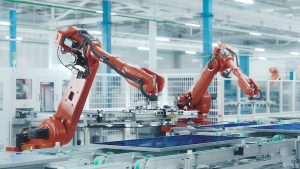In last month’s blog, we explained how the Industrial Internet of Things (IIoT) environment, which encompases the convergence of IT and operational technology (OT), is a world first for Schneider. In a multiple drive pump environment for example, operators of Services Oriented Drives can adjust speed, functions and electrical parameters.
Non-electrical data from Services Oriented Drives also feeds into customer business software and analytics via the Cloud, while for example helping operators to make decisions about which pumps to switch to if the efficiency of a pump is too low, if a pump fails or if it requires maintenance. With Services Oriented Drives, operators may control not only motor speed for pump flow, but also acceleration for pressure and level sensing for volume.
Harmonics and power quality are different issues but often linked together in the context of variable speed drives and the holy grail of electrical engineers is to maximize pump performance while minimizing its energy consumption. Services Oriented Drives have embeded energy metering, which can be used to confirm whether there are real energy savings via Ethernet connection from the drive web server.
The power conversion circuitry on motor drives generates harmonics and other electrical disturbances, which in turn generate energy losses, so harmonics mitigation is embedded in Services Oriented Drives, unlike traditional motor drive environments where a separate box has to be installed.
Reducing harmonics makes the electrical installation both safer and more energy efficient. Services Oriented Drives uses a combination of hardware and software to provide electrical filtering of harmonics. Energy intensive industries like water and wastewater, mining and minerals, oil and gas, and food and beverage are a key target market for Services Oriented Drives and smart connected devices.
Water and wastewater industries for example stand to benefit from remote connectivity, energy efficiency and harmonic mitigation. In the case of mining, benefits include harmonics mitigation and remote monitoring but with a particular requirement for torque performance on motor acceleration. For food and beverage industries, there are specific waterproof Services Oriented Drives available.
Remote asset monitoring and harmonics mitigation are critical factors in industries like mining where there are usually long conveyor runs and long electrical cables, with their attendant voltage drop and associated electrical noise problems, as well as in the oil and gas and water and wastewater industries.
Turning to different countries’ water industries for example, the UK water industry is typically made up of a number of large utilities that get together in associations like the Water Industry Mechanical and Electrical Specifications (WIMES) to set down specifications, whereas in France, there are two primary operators – Veolia and Suez. Regardless of individual country setup, Services Oriented Drives will adapt to all requirements and specifications.
In the next blog, we will explore issues such as asset management and maintenance, Integration with automation systems and documentation and case recording.



